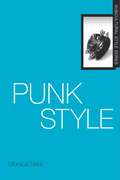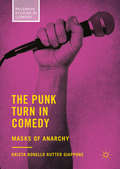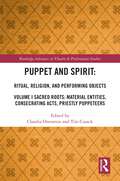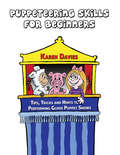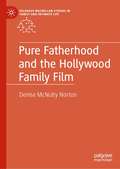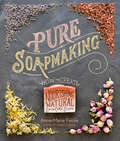- Table View
- List View
Punk Rock (Student Editions)
by Simon Stephens Catherine LoveEverything human beings do finishes up bad in the end. Everything good human beings ever make is built on something monstrous. Nothing lasts. We certainly won't . . . William Carlisle has the world at his feet, but its weight on his shoulders. He is intelligent, articulate and f***ed. In the library of a grammar school, William and his fellow sixth-formers are preparing for their mock A-Levels while navigating the pressures of teenage life. They are educated and aspirational young people, but step-by-step, the dislocation, disjunction and latent aggression is revealed.Punk Rock premiered at the Lyric Hammersmith on 3 September 2009 in a co-production between Lyric Hammersmith and the Royal Exchange Theatre, Manchester. It is published here as a Student Edition featuring commentary and notes by Catherine Love. The ancillary material is geared at students and considers:- an introduction outlining the play's plot, character, themes, context and performance history- the full text of the play- a chronology of the playwright's life and work- a detailed introductory analysis - extensive textual notes - questions for further studyMethuen Drama Student Editions are expertly annotated texts of a wide range of plays from the modern and classic repertoires.This play includes some strong language and violent scenes.
Punk Rock: Harper Regan, Punk Rock, Marine Parade And On The Shore Of The Wide World (Student Editions)
by Simon Stephens Catherine LoveEverything human beings do finishes up bad in the end. Everything good human beings ever make is built on something monstrous. Nothing lasts. We certainly won't . . . William Carlisle has the world at his feet, but its weight on his shoulders. He is intelligent, articulate and f***ed. In the library of a grammar school, William and his fellow sixth-formers are preparing for their mock A-Levels while navigating the pressures of teenage life. They are educated and aspirational young people, but step-by-step, the dislocation, disjunction and latent aggression is revealed.Punk Rock premiered at the Lyric Hammersmith on 3 September 2009 in a co-production between Lyric Hammersmith and the Royal Exchange Theatre, Manchester. It is published here as a Student Edition featuring commentary and notes by Catherine Love. The ancillary material is geared at students and considers:- an introduction outlining the play's plot, character, themes, context and performance history- the full text of the play- a chronology of the playwright's life and work- a detailed introductory analysis - extensive textual notes - questions for further studyMethuen Drama Student Editions are expertly annotated texts of a wide range of plays from the modern and classic repertoires.This play includes some strong language and violent scenes.
The punk rock politics of Joe Strummer: Radicalism, resistance and rebellion
by Gregor GallJoe Strummer was one of the twentieth century’s iconic rock’n’roll rebels. As frontperson, spokesperson and chief lyricist for The Clash, he played a major role in politicising a generation through some of the most powerful protest songs of the era, songs like ‘White Riot’, ‘English Civil War’ and ‘London Calling’. At the heart of this protest was the struggle for social justice and equality.The punk rock politics of Joe Strummer examines Strummer’s beliefs on a range of issues – including socialism, alienation, exploitation, multiculturalism and humanism - analysing their credibility, influence and impact, and asking where they came from and how they developed over time. Drawing on Strummer’s lyrics, various interviews and bootleg recordings, as well as interviews with those he inspired, The punk rock politics of Joe Strummer takes the reader on a journey through the political influences and motivations that defined one of the UK’s greatest punk icons.
The punk rock politics of Joe Strummer: Radicalism, resistance and rebellion
by Gregor GallJoe Strummer was one of the twentieth century’s iconic rock’n’roll rebels. As frontperson, spokesperson and chief lyricist for The Clash, he played a major role in politicising a generation through some of the most powerful protest songs of the era, songs like ‘White Riot’, ‘English Civil War’ and ‘London Calling’. At the heart of this protest was the struggle for social justice and equality.The punk rock politics of Joe Strummer examines Strummer’s beliefs on a range of issues – including socialism, alienation, exploitation, multiculturalism and humanism - analysing their credibility, influence and impact, and asking where they came from and how they developed over time. Drawing on Strummer’s lyrics, various interviews and bootleg recordings, as well as interviews with those he inspired, The punk rock politics of Joe Strummer takes the reader on a journey through the political influences and motivations that defined one of the UK’s greatest punk icons.
Punk Style (Subcultural Style)
by Monica SklarPunk Style examines the dress of this incredibly diverse, long-lasting and hugely influential subculture and its impact on mainstream fashion. Taking a comprehensive approach, the book includes a historical overview, a discussion of motivations behind dress practices, and a review of fashion cycles and merchandising methods. Punk is frequently positioned as a forerunner of trends that later become commonplace, as demonstrated in the proliferation and acceptance of body modification, the repeated use of deconstruction as a design aesthetic, and the recent boom in fashion that reflects DIY style through handmade crafts. The book explores how this dominant subcultural style continues to expand via the internet, youth buying-power, and the constant re-appropriation of its distinctive styles.This accessible text brings the discussion of punk fashion up-to-date and provides a concise overview for students and scholars and general readers interested in the punk subculture.
Punk Style (Subcultural Style)
by Monica SklarPunk Style examines the dress of this incredibly diverse, long-lasting and hugely influential subculture and its impact on mainstream fashion. Taking a comprehensive approach, the book includes a historical overview, a discussion of motivations behind dress practices, and a review of fashion cycles and merchandising methods. Punk is frequently positioned as a forerunner of trends that later become commonplace, as demonstrated in the proliferation and acceptance of body modification, the repeated use of deconstruction as a design aesthetic, and the recent boom in fashion that reflects DIY style through handmade crafts. The book explores how this dominant subcultural style continues to expand via the internet, youth buying-power, and the constant re-appropriation of its distinctive styles.This accessible text brings the discussion of punk fashion up-to-date and provides a concise overview for students and scholars and general readers interested in the punk subculture.
The Punk Turn in Comedy
by Krista Bonello Rutter GiapponeThis book examines the interconnections between punk and alternative comedy (altcom). It explores how punk’s tendency towards humour and parody influenced the trajectory taken by altcom in the UK, and the punk strategies introduced when altcom sought self-definition against dominant established trends. The Punk Turn in Comedy considers the early promise of punk-comedy convergence in Peter Cook and Dudley Moore’s ‘Derek and Clive’, and discusses punk and altcom’s attitudes towards dominant traditions. The chapters demonstrate how punk and altcom sought a direct approach for critique, one that rejected innuendo, while embracing the ‘amateur’ in style and experimenting with audience-performer interaction. Giappone argues that altcom tended to be more consistently politicised than punk, with a renewed emphasis on responsibility. The book is a timely exploration of the ‘punk turn’ in comedy history, and will speak to scholars of both comedy and punk studies.
Punts (Modern Plays)
by Sarah Page'You want me to have full penetrative sex with your son, right? I just wanted to, you know, check.'Jack, a young man with a learning disability, lives at home, cared for by his devoted parents. Like most men in their twenties, he has needs – his mates at the rugby club talk about nothing but getting laid, whilst Jack's most erotic experience to date is the time he was winked at by the pretty cashier in Lloyds. Desperate for their son to not feel left out, his parents decide to bring in a professional. But the woman they hire has a far more profound impact on the whole family than they could ever have imagined.Written by up-and-coming writer Sarah Page, this text has been published to coincide with Kuleshov Theatre's 2017 production at Theatre503.
Punts (Modern Plays)
by Sarah Page'You want me to have full penetrative sex with your son, right? I just wanted to, you know, check.'Jack, a young man with a learning disability, lives at home, cared for by his devoted parents. Like most men in their twenties, he has needs – his mates at the rugby club talk about nothing but getting laid, whilst Jack's most erotic experience to date is the time he was winked at by the pretty cashier in Lloyds. Desperate for their son to not feel left out, his parents decide to bring in a professional. But the woman they hire has a far more profound impact on the whole family than they could ever have imagined.Written by up-and-coming writer Sarah Page, this text has been published to coincide with Kuleshov Theatre's 2017 production at Theatre503.
Puppet: An Essay on Uncanny Life
by Kenneth GrossThe puppet creates delight and fear. It may evoke the innocent play of childhood, or become a tool of ritual magic, able to negotiate with ghosts and gods. Puppets can be creepy things, secretive, inanimate while also full of spirit, alive with gesture and voice. In this eloquent book, Kenneth Gross contemplates the fascination of these unsettling objects—objects that are also actors and images of life. The poetry of the puppet is central here, whether in its blunt grotesquery or symbolic simplicity, and always in its talent for metamorphosis. On a meditative journey to seek the idiosyncratic shapes of puppets on stage, Gross looks at the anarchic Punch and Judy show, the sacred shadow theater of Bali, and experimental theaters in Europe and the United States, where puppets enact everything from Baroque opera and Shakespearean tragedy to Beckettian farce. Throughout, he interweaves accounts of the myriad faces of the puppet in literature—Collodi’s cruel, wooden Pinocchio, puppetlike characters in Kafka and Dickens, Rilke’s puppet-angels, the dark puppeteering of Philip Roth’s Micky Sabbath—as well as in the work of artists Joseph Cornell and Paul Klee. The puppet emerges here as a hungry creature, seducer and destroyer, demon and clown. It is a test of our experience of things, of the human and inhuman. A book about reseeing what we know, or what we think we know, Puppet evokes the startling power of puppets as mirrors of the uncanny in life and art.
Puppet: An Essay on Uncanny Life
by Kenneth GrossThe puppet creates delight and fear. It may evoke the innocent play of childhood, or become a tool of ritual magic, able to negotiate with ghosts and gods. Puppets can be creepy things, secretive, inanimate while also full of spirit, alive with gesture and voice. In this eloquent book, Kenneth Gross contemplates the fascination of these unsettling objects—objects that are also actors and images of life. The poetry of the puppet is central here, whether in its blunt grotesquery or symbolic simplicity, and always in its talent for metamorphosis. On a meditative journey to seek the idiosyncratic shapes of puppets on stage, Gross looks at the anarchic Punch and Judy show, the sacred shadow theater of Bali, and experimental theaters in Europe and the United States, where puppets enact everything from Baroque opera and Shakespearean tragedy to Beckettian farce. Throughout, he interweaves accounts of the myriad faces of the puppet in literature—Collodi’s cruel, wooden Pinocchio, puppetlike characters in Kafka and Dickens, Rilke’s puppet-angels, the dark puppeteering of Philip Roth’s Micky Sabbath—as well as in the work of artists Joseph Cornell and Paul Klee. The puppet emerges here as a hungry creature, seducer and destroyer, demon and clown. It is a test of our experience of things, of the human and inhuman. A book about reseeing what we know, or what we think we know, Puppet evokes the startling power of puppets as mirrors of the uncanny in life and art.
Puppet: An Essay on Uncanny Life
by Kenneth GrossThe puppet creates delight and fear. It may evoke the innocent play of childhood, or become a tool of ritual magic, able to negotiate with ghosts and gods. Puppets can be creepy things, secretive, inanimate while also full of spirit, alive with gesture and voice. In this eloquent book, Kenneth Gross contemplates the fascination of these unsettling objects—objects that are also actors and images of life. The poetry of the puppet is central here, whether in its blunt grotesquery or symbolic simplicity, and always in its talent for metamorphosis. On a meditative journey to seek the idiosyncratic shapes of puppets on stage, Gross looks at the anarchic Punch and Judy show, the sacred shadow theater of Bali, and experimental theaters in Europe and the United States, where puppets enact everything from Baroque opera and Shakespearean tragedy to Beckettian farce. Throughout, he interweaves accounts of the myriad faces of the puppet in literature—Collodi’s cruel, wooden Pinocchio, puppetlike characters in Kafka and Dickens, Rilke’s puppet-angels, the dark puppeteering of Philip Roth’s Micky Sabbath—as well as in the work of artists Joseph Cornell and Paul Klee. The puppet emerges here as a hungry creature, seducer and destroyer, demon and clown. It is a test of our experience of things, of the human and inhuman. A book about reseeing what we know, or what we think we know, Puppet evokes the startling power of puppets as mirrors of the uncanny in life and art.
Puppet: An Essay on Uncanny Life
by Kenneth GrossThe puppet creates delight and fear. It may evoke the innocent play of childhood, or become a tool of ritual magic, able to negotiate with ghosts and gods. Puppets can be creepy things, secretive, inanimate while also full of spirit, alive with gesture and voice. In this eloquent book, Kenneth Gross contemplates the fascination of these unsettling objects—objects that are also actors and images of life. The poetry of the puppet is central here, whether in its blunt grotesquery or symbolic simplicity, and always in its talent for metamorphosis. On a meditative journey to seek the idiosyncratic shapes of puppets on stage, Gross looks at the anarchic Punch and Judy show, the sacred shadow theater of Bali, and experimental theaters in Europe and the United States, where puppets enact everything from Baroque opera and Shakespearean tragedy to Beckettian farce. Throughout, he interweaves accounts of the myriad faces of the puppet in literature—Collodi’s cruel, wooden Pinocchio, puppetlike characters in Kafka and Dickens, Rilke’s puppet-angels, the dark puppeteering of Philip Roth’s Micky Sabbath—as well as in the work of artists Joseph Cornell and Paul Klee. The puppet emerges here as a hungry creature, seducer and destroyer, demon and clown. It is a test of our experience of things, of the human and inhuman. A book about reseeing what we know, or what we think we know, Puppet evokes the startling power of puppets as mirrors of the uncanny in life and art.
Puppet: An Essay on Uncanny Life
by Kenneth GrossThe puppet creates delight and fear. It may evoke the innocent play of childhood, or become a tool of ritual magic, able to negotiate with ghosts and gods. Puppets can be creepy things, secretive, inanimate while also full of spirit, alive with gesture and voice. In this eloquent book, Kenneth Gross contemplates the fascination of these unsettling objects—objects that are also actors and images of life. The poetry of the puppet is central here, whether in its blunt grotesquery or symbolic simplicity, and always in its talent for metamorphosis. On a meditative journey to seek the idiosyncratic shapes of puppets on stage, Gross looks at the anarchic Punch and Judy show, the sacred shadow theater of Bali, and experimental theaters in Europe and the United States, where puppets enact everything from Baroque opera and Shakespearean tragedy to Beckettian farce. Throughout, he interweaves accounts of the myriad faces of the puppet in literature—Collodi’s cruel, wooden Pinocchio, puppetlike characters in Kafka and Dickens, Rilke’s puppet-angels, the dark puppeteering of Philip Roth’s Micky Sabbath—as well as in the work of artists Joseph Cornell and Paul Klee. The puppet emerges here as a hungry creature, seducer and destroyer, demon and clown. It is a test of our experience of things, of the human and inhuman. A book about reseeing what we know, or what we think we know, Puppet evokes the startling power of puppets as mirrors of the uncanny in life and art.
Puppet: An Essay on Uncanny Life
by Kenneth GrossThe puppet creates delight and fear. It may evoke the innocent play of childhood, or become a tool of ritual magic, able to negotiate with ghosts and gods. Puppets can be creepy things, secretive, inanimate while also full of spirit, alive with gesture and voice. In this eloquent book, Kenneth Gross contemplates the fascination of these unsettling objects—objects that are also actors and images of life. The poetry of the puppet is central here, whether in its blunt grotesquery or symbolic simplicity, and always in its talent for metamorphosis. On a meditative journey to seek the idiosyncratic shapes of puppets on stage, Gross looks at the anarchic Punch and Judy show, the sacred shadow theater of Bali, and experimental theaters in Europe and the United States, where puppets enact everything from Baroque opera and Shakespearean tragedy to Beckettian farce. Throughout, he interweaves accounts of the myriad faces of the puppet in literature—Collodi’s cruel, wooden Pinocchio, puppetlike characters in Kafka and Dickens, Rilke’s puppet-angels, the dark puppeteering of Philip Roth’s Micky Sabbath—as well as in the work of artists Joseph Cornell and Paul Klee. The puppet emerges here as a hungry creature, seducer and destroyer, demon and clown. It is a test of our experience of things, of the human and inhuman. A book about reseeing what we know, or what we think we know, Puppet evokes the startling power of puppets as mirrors of the uncanny in life and art.
Puppet and Spirit: Volume I Sacred Roots: Material Entities, Consecrating Acts, Priestly Puppeteers (Routledge Advances in Theatre & Performance Studies)
by Claudia OrensteinThis anthology of essays aims to explore the many types of relationships that exist between puppets, broadly speaking, and the immaterial world. The allure of the puppet goes beyond its material presence as, historically and throughout the globe, many uses of puppets and related objects have expressed and capitalized on their posited connections to other realms or ability to serve as vessels or conduits for immaterial presence. The flip side of the puppet’s troubling uncanniness is precisely the possibilities it represents for connecting to discarnate realities. Where do we see such connections? How do we describe, analyze, and theorize these relationships? The first of two volumes, this book focuses on these questions in relation to long-established, traditional practices using puppets, devotional objects, and related items with sacred aspects to them or that perform ritual roles. Looking at performance traditions and artifacts from China, Indonesia, Korea, Mali, Brazil, Iran, Germany, and elsewhere, the essays from scholars and practitioners provide a range of useful models and critical vocabularies for addressing the ritual and spiritual aspects of puppet performance, further expanding the growing understanding and appreciation of puppetry generally. This book, along with its companion volume, offers, for the first time, robust coverage of this subject from a diversity of voices, examples, and perspectives.
Puppet and Spirit: Volume II Contemporary Branchings: Secular Benedictions, Activated Energies, Uncanny Faiths (ISSN)
by Claudia Orenstein Tim CusackThis anthology of essays, a companion to Puppet and Spirit: Ritual, Religion, and Performing Objects, Volume I, aims to explore the many types of relationships that exist between puppets, broadly speaking, and the immaterial world.The allure of the puppet goes beyond its material presence as, historically and throughout the globe, many uses of puppets and related objects have expressed and capitalized on their posited connections to other realms or ability to serve as vessels or conduits for immaterial presence. The flip side of the puppet’s troubling uncanniness is precisely the possibilities it represents for connecting to discarnate realities. Where do we see such connections in contemporary artistic work in various mediums? How do puppets open avenues for discussion in a world that seems to be increasingly polarized around religious values? How do we describe, analyze, and theorize the present moment? What new questions do puppets address for our times, and how does the puppet’s continued entanglement with these concerns trouble or comfort us? The essays in this book, from scholars and practitioners, provide a range of useful models and critical vocabularies for addressing this aspect of puppet performance, further expanding the growing understanding and appreciation of puppetry generally.This book, along with its companion volume, offers, for the first time, robust coverage of this subject from a diversity of voices, examples, and perspectives.
Puppet and Spirit: Volume I Sacred Roots: Material Entities, Consecrating Acts, Priestly Puppeteers (Routledge Advances in Theatre & Performance Studies)
This anthology of essays aims to explore the many types of relationships that exist between puppets, broadly speaking, and the immaterial world. The allure of the puppet goes beyond its material presence as, historically and throughout the globe, many uses of puppets and related objects have expressed and capitalized on their posited connections to other realms or ability to serve as vessels or conduits for immaterial presence. The flip side of the puppet’s troubling uncanniness is precisely the possibilities it represents for connecting to discarnate realities. Where do we see such connections? How do we describe, analyze, and theorize these relationships? The first of two volumes, this book focuses on these questions in relation to long-established, traditional practices using puppets, devotional objects, and related items with sacred aspects to them or that perform ritual roles. Looking at performance traditions and artifacts from China, Indonesia, Korea, Mali, Brazil, Iran, Germany, and elsewhere, the essays from scholars and practitioners provide a range of useful models and critical vocabularies for addressing the ritual and spiritual aspects of puppet performance, further expanding the growing understanding and appreciation of puppetry generally. This book, along with its companion volume, offers, for the first time, robust coverage of this subject from a diversity of voices, examples, and perspectives.
Puppet and Spirit: Volume II Contemporary Branchings: Secular Benedictions, Activated Energies, Uncanny Faiths (ISSN)
This anthology of essays, a companion to Puppet and Spirit: Ritual, Religion, and Performing Objects, Volume I, aims to explore the many types of relationships that exist between puppets, broadly speaking, and the immaterial world.The allure of the puppet goes beyond its material presence as, historically and throughout the globe, many uses of puppets and related objects have expressed and capitalized on their posited connections to other realms or ability to serve as vessels or conduits for immaterial presence. The flip side of the puppet’s troubling uncanniness is precisely the possibilities it represents for connecting to discarnate realities. Where do we see such connections in contemporary artistic work in various mediums? How do puppets open avenues for discussion in a world that seems to be increasingly polarized around religious values? How do we describe, analyze, and theorize the present moment? What new questions do puppets address for our times, and how does the puppet’s continued entanglement with these concerns trouble or comfort us? The essays in this book, from scholars and practitioners, provide a range of useful models and critical vocabularies for addressing this aspect of puppet performance, further expanding the growing understanding and appreciation of puppetry generally.This book, along with its companion volume, offers, for the first time, robust coverage of this subject from a diversity of voices, examples, and perspectives.
Puppeteering Skills for Beginners: Tips, Tricks and Hints to Performing Glove Puppet Shows
by Karen DaviesKaren has been writing and performing puppet shows for years, and has developed a range of characters. In this guide to skills she will show you how to make your performances better with simple, subtle techniques. Photographs to show you correct hand and body positions, this guide is an invaluable addition to any puppet performer's kit bag.
Puppetry: A Reader in Theatre Practice (Readings in Theatre Practice)
by Penny FrancisIn this sophisticated and compelling introduction to puppet theatre, Penny Francis offers engaging contemporary perspectives on this universal art-form. She provides an account of puppetry's different facets, from its demands and techniques, through its uses and abuses, to its history and philosophy. Now recognized as a valuable and powerful medium used in the making of most forms of theatre and filmed work, those referring to Puppetry will discover something of the roots, dramaturgy, literature and techniques of this visual art form. The book gathers together material from an international selection of sources, bringing puppet theatre to life for the student, practitioner and amateur alike.
Puppets and Cities: Articulating Identities in Southeast Asia
by Jennifer GoodlanderNations in Southeast Asia have gone through a period of rapid change within the last century as they have grappled with independence, modernization, and changing political landscapes. Governments and citizens strive to balance progress with the need to articulate identities that resonate with the pre-colonial past and look towards the future. Puppets and Cities: Articulating Identities in Southeast Asia addresses how puppetry complements and combines with urban spaces to articulate present and future cultural and national identities. Puppetry in Southeast Asia is one of the oldest and most dynamic genres of performance. Bangkok, Jakarta, Phnom Penh, and other dynamic cities are expanding and rapidly changing. Performance brings people together, offers opportunities for economic growth, and bridges public and private spheres. Whether it is a traditional shadow performance borrowing from Star Wars or giant puppets parading down the street-this book examines puppets as objects and in performance to make culture come alive. Based on several years of field research-watching performances, working with artists, and interviewing key stakeholders in Southeast Asian cultural production-the book offers a series of rich case studies of puppet performance from various locations, including: theatre in suburban Bangkok; puppets in museums in Jakarta, Indonesia; puppet companies from Laos PDR, the National Puppet Theatre of Vietnam, and the Giant Puppet Project in Siem Reap, Cambodia; new global puppetry networks through social media; and how puppeteers came together from around the region to create a performance celebrating ASEAN identity.
Puppets and Cities: Articulating Identities in Southeast Asia
by Jennifer GoodlanderNations in Southeast Asia have gone through a period of rapid change within the last century as they have grappled with independence, modernization, and changing political landscapes. Governments and citizens strive to balance progress with the need to articulate identities that resonate with the pre-colonial past and look towards the future. Puppets and Cities: Articulating Identities in Southeast Asia addresses how puppetry complements and combines with urban spaces to articulate present and future cultural and national identities. Puppetry in Southeast Asia is one of the oldest and most dynamic genres of performance. Bangkok, Jakarta, Phnom Penh, and other dynamic cities are expanding and rapidly changing. Performance brings people together, offers opportunities for economic growth, and bridges public and private spheres. Whether it is a traditional shadow performance borrowing from Star Wars or giant puppets parading down the street-this book examines puppets as objects and in performance to make culture come alive. Based on several years of field research-watching performances, working with artists, and interviewing key stakeholders in Southeast Asian cultural production-the book offers a series of rich case studies of puppet performance from various locations, including: theatre in suburban Bangkok; puppets in museums in Jakarta, Indonesia; puppet companies from Laos PDR, the National Puppet Theatre of Vietnam, and the Giant Puppet Project in Siem Reap, Cambodia; new global puppetry networks through social media; and how puppeteers came together from around the region to create a performance celebrating ASEAN identity.
Pure Fatherhood and the Hollywood Family Film (Palgrave Macmillan Studies in Family and Intimate Life)
by Denise McNulty NortonThis book maps father failure and redemption through three decades of Hollywood family films, revealing how libertarian notions that align agency with autonomy lead to new conflicts for the contemporary father. The films find resolution to these conflicts through a re-gendering of parenting as relationship. In their creation of a ‘pure’ fatherhood that is valorised as authentic for its lack of parental responsibilities, the films serve to challenge the perception that fathering enacted outside the nuclear family structure is fragile. McNulty Norton finds in the films a new essentialism that secures the pure relationship to the biological father, reinforcing his position in the face of changing family forms.
Pure Soapmaking: How to Create Nourishing, Natural Skin Care Soaps
by Anne-Marie FaiolaThe pure luxury of soaps made with coconut butter, almond oil, aloe vera, oatmeal, and green tea is one of life&’s little pleasures. And with the help of Anne-Marie Faiola, author of Soap Crafting and Milk Soaps, it&’s easy to make luscious, all-natural soaps right in your own kitchen. This collection of 32 recipes ranges from simple castile bars to intricate swirls, embeds, and marbled and layered looks. Begin with a combination of skin-nourishing oils and then add blueberry puree, dandelion-infused water, almond milk, coffee grounds, mango and avocado butters, black tea, or other delicious ingredients — and then scent your soap with pure essential oils. Step-by-step photography guides you through every stage of cold-process soapmaking.



